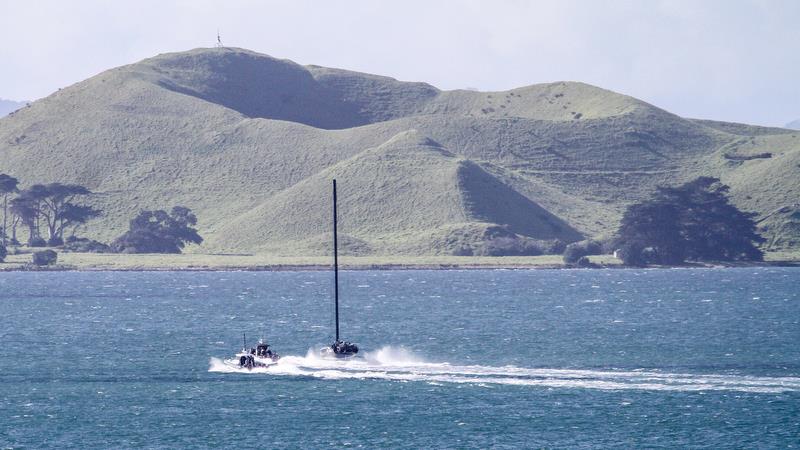
America's Cup Rialto: August 7 - American Magic circuit trains in the Paddock
by Richard Gladwell/Sail-World.com/NZ 7 Aug 2020 19:35 PDT
8 August 2020

American Magic - under tow - heads for Tamaki Strait with Browns Island in the background - Auckland - August 7, 2020 - 36th America's Cup © Richard Gladwell / Sail-World.com
American Magic's Defiant left their base around 1030hrs on a fast 10nm foil-borne around for another training session out on Course E - between Eastern Beach and Waiheke Island, otherwise known as "The Paddock".
The breeze was offshore, flicking around 15-20kts and quite variable in pressure. Later in the afternoon Auckland was hit by a forecasted 30kt front gusting over 40kts - which arrived after Defiant arrived back at the Wynyard Marina. The sharp increase in wind highlights the need for good forecasting and keeping an eye on the sometimes rapidly changing situation, typical of the Auckland winter.
Generally sailing conditions were good, with flat seas, and the team did a series of windward leewards around a couple of laid marks.
From the shore it looked to be a good session, but it was hard to pick up the dry tacks and gybes without reviewing an image stream. That exercise did show that while many look at video and call a dry tack or gybe a few metres after the maneuver hits the new sailing angle. But as was evident today, and has been seen many times before with ETNZ, the AC75 can touchdown 12-15 seconds or more into the exit phase.
The timings (off the camera and not a stopwatch) are as follows: from the first shot to the second (foiling fast to both foils immersed) is 26 seconds. From the second shot to the third (head to wind) is three seconds. From that head to wind position to the final shot the time taken is 15 seconds - which is not a tragedy in itself - but illustrates that a dry tack is not completed at Position 4. The sink at Position 5 can be attributed to a number of reasons given that the usual role of the rudder wings are to develop downward pressure. However the rudder box can be controlled for fore and after as well as athwartships movement.
From a distance the scow hull looked to struggle a little getting clear, and often went bow-up if they ran out hit a soft sport in the breeze. While the skiff shape tends to use its bustle volume to get some immediate hull support, and then climbs away. It may be that the increased wetted surface of the scow creates more drag and slows the recovery process. In its favour the scow shape forms a much better endplate effect between the hull and water surface.
Certainly in the photos on this page of the stern/bow sections of both the scow (Defiant) and stern section of the skiff (Te Aihe) highlight the difference between the two genres.
Unfortunately the overcast sky, poor light and offshore distance affected long range photography at The Paddock.
We will have a better idea next week, when it is expected that both AC75's Te Aihe and Defiant are out on the same patch of water.